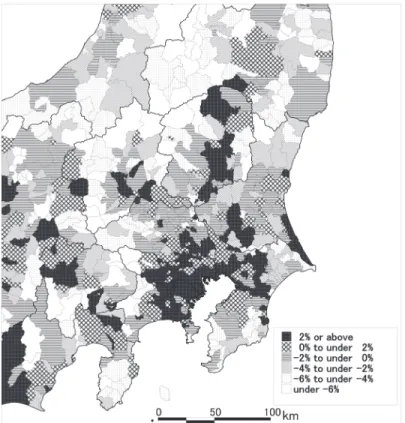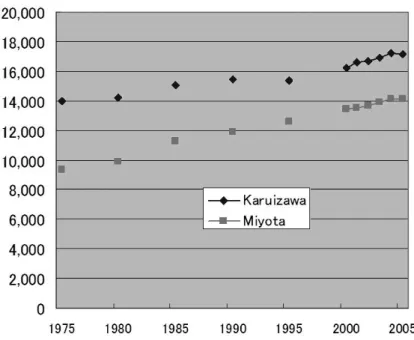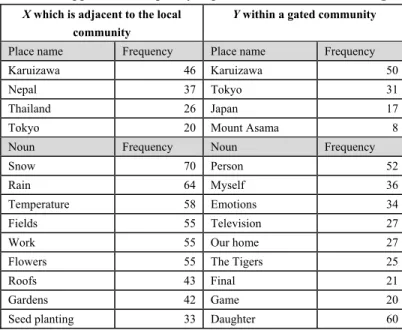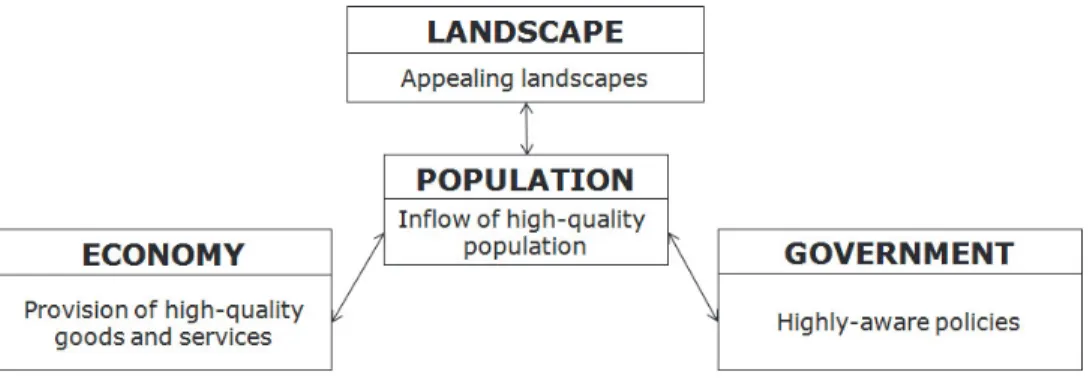The Progress of Population Inflow and Rural Gentrification in
Karuizawa on the Outskirts of the Tokyo Metropolitan Area
Mitsuru YAMAMOTO Ⅰ. New Trends in Population Movements between Urban and Rural Areas
As a result of the progress of urbanization and industrialization, negative phenomena affecting rural communities and rural landscape have occurred in rural areas, with aging of the population due to population outflow and the conversion of agricultural land use to extensive farming on the one hand, and more crowded housing due to the inflow of city residents and the conversion of agricultural land to urban land use, etc. on the other hand. In rural studies as well, including geography, efforts are being made to understand these negative phenomena. Nonetheless, in recent years farmers have continued residing in rural areas, and new arrivals from the cities have commenced a rural life, and as a result regions have started to appear in which a good rural environment including landscape and infrastructure is being maintained (Irmen and Blach 1997; Schmied 2000). The background to this is thought to be the higher incomes of farmers and changes in their perceptions of life, and the fact that the values of migrants to rural areas and their resulting behavior sought to not only maintain the previous rural environment but also to achieve a higher quality environment than previously. We are in an era in which the character of rural areas is now transforming greatly due to these changes in the qualities of residents.
The qualitative changes in rural areas resulting from these population fluctuations have already been seen in Europe and the United States, and in recent years attempts to understand that phenomenon as “rural gentrification” have begun (Cloke et al. 1998; Stockdale 2010). Rural gentrification was originally the migration by the middle class from cities to rural areas seeking the pastoral life, and is now a concept indicating the results of these major changes in the social environment and the natural environment, in particular their qualitative improvement. The high purchasing power and high demand level of these middle class people not only brought about the beautification of their residential areas and their surrounding environment; it also made the improvement of government services and the local establishment of high level commercial service functions possible, and led to the maintenance of the rural environment. Rural gentrification can also be understood as a concept which describes the qualitative changes of rural areas inclusively and comprehensively, going beyond merely the social aspects and natural environment aspects of rural areas to include government, commerce and rural landscape as well, and is effective for helping us to understand the qualitative changes in the rural areas of Japan today. Moreover, rural gentrification can be interpreted as one aspect of the commodification of rural areas because the landscape and environment of rural areas are perceived as a appealing “commodity” by city residents.
changes what kinds of changes will be brought about in rural landscape, the local establishment of non-agricultural functions, and governments in rural areas, and moreover how these changes are related to each other.
Here we will take up the example of the resort regions on the outskirts of the Tokyo Metropolitan Area in which these qualitative changes in rural areas seem to be particularly striking, and, from the perspective of what kinds of commodity value rural areas have for the migrants, we will additionally examine how population movements between urban and rural areas are actually occurring, the kinds of processes through which these reverse population movements are taking place, and what kind of meaning the migrants have in rural areas.
Ⅱ. Reverse Population Movements on the Outskirts of the Tokyo Metropolitan Area
Looking at the population trends in the Tokyo Metropolitan Area from 2000 to 2005 (Figure 1), population increases are striking in the Tokyo wards and the surrounding areas, and a return of population to the city center as a result of the fall in land prices after the collapse of the economic bubble can be discerned. Furthermore, population increases can be seen in the areas surrounding the locations of the prefectural government offices in the neighboring prefectures, so we can conclude that
concentration of population in cities in the major metropolitan areas is progressing. On the other hand, cities, towns, and villages located in zones over 50 kilometers from the Tokyo city center are mostly showing population decline except for those areas surrounding the locations of the prefectural government offices, and even in the Tokyo Metropolitan Area the outflow of population from rural areas to cities is continuing.
Nonetheless, in these farming and mountain village regions in which the population is declining there exist a few scattered regions in which the population is increasing. These include the areas surrounding Nasunogahara, the areas surrounding Karuizawa, the areas surrounding the Fuji Five Lakes, etc., which are located about 100 kilometers from the Tokyo city center. These are regions positioned as resorts on the outskirts of the Tokyo Metropolitan Area, which have seen a lot of construction of tourist facilities such as hotels, pensions, etc. and second houses for city residents. It is thought that this good landscape and environment contributes to the formation of resorts, and the infrastructure developed through the resort formation further increases the value-as-commodities of these regions.
Ⅲ. The Population Inflow Process in Karuizawa
1. Formation of the highland resort “Karuizawa”: increase of the value-as-commodities of landscape and the environment
The town of Karuizawa is located on highlands at the eastern edge of Nagano Prefecture on the sloping southern foothills of Mount Asama at 900-1,000 meters above sea level. The mean temperature in August is 20.3°C, nearly seven degrees lower than that of Tokyo. It has good access to Tokyo due to the Joshin-etsu Expressway and the Hokuriku shinkansen, making it the leading resort area which has the Tokyo Metropolitan Area as its market.
The trigger for the formation of this resort was the construction of vacation homes by westerners who flowed into Japan in the Meiji era. In 1888 Canadian Alexander Croft Shaw constructed the first vacation home in Karuizawa. Subsequently, a stream of foreigners visited Karuizawa and built vacation homes there. Before long it was not only foreigners building the vacation homes in Karuizawa. Japanese people, including the nobility, leading figures in the political and business establishment, literary figures, etc. began to construct them as well. The construction of vacation homes was encouraged by the booming economy in the Taisho era (Sato and Saito 2004).
As a result of the rapid economic growth after the Second World War, vacation home construction progressed further in Karuizawa. In addition to vacation homes, hotels and ryokan (Japanese inns), resort facilities, and sports facilities were constructed, and a broader range of people began to visit Karuizawa. In particular, the wedding of the Crown Prince increased interest in Karuizawa (Uchida 1989).
Figure 2: Population changes in the town of Karuizawa and the town of Miyota (Source:Karuizawa Municipal Government and Miyota Municipal Government documents)
began to move from urban areas to Karuizawa to settle down. As can be seen in Figure 2, the population has been consistently increasing since the 1970s in the town of Miyota adjacent to the town of Karuizawa and the rate of the population increase has been rising in Karuizawa from 2000 onwards in particular.
These population increases were brought about by population inflow, and looking at the changes in the population pyramid (Figure 3), we can see that the inflow of people in their 50s and 60s is striking for both males and females. In other words, the group of people migrating to Karuizawa was formed as a consequence of the retirement of the so-called baby-boomer generation when they reached retirement age. This generation born in the first baby boom period after the Second World War account for approximately 5% of the total population and the majority of them are resident in major urban regions such as Tokyo, etc. However, many of these people were born in rural regions, and migrated to city areas for study or work. They have been selecting Karuizawa as one of their migration destinations when they reach retirement age.
2. The migration decision and settlement of the new arrivals
We attempted to clarify what kind of processes the people flowing into Karuizawa from urban areas went through when making the decision to migrate and moving to Karuizawa, based on the statements of some of the people who actually migrated there (Beppu 2006).
“The resort facilities of the company I used to work for are in Karuizawa, and I also like golf, so I thought this is where I should live.”
“I had a resort condominium in Karuizawa already. Then I searched for land. I thought I would switch from a condominium to a stand-alone house with a garden. The local real estate agent showed me various places. I did not consider anywhere other than Karuizawa if I was going to move away from Tokyo. The access by car is good, the shinkansen is also good, and of course there is the environment…”
“I did not think about moving anywhere else at all. The resort facilities of the company I used to work for and the vacation homes of my relatives were in Karuizawa. I had been coming here for a long time…”
they did not know at all lowered the hurdles to migrating there. In this way the people who decided to settle in Karuizawa emerged from among the people who had deeply experienced Karuizawa.
Then the group that decided to migrate actually searched for and obtained real estate in Karuizawa. They made statements like the following about this (Beppu 2006).
“Most of my information sources were on the Internet, and at the end I used real estate agents to show me the properties. Most of the real estate agents actively helped me.”
“I referred to the blog of a person who was already living in the town of Karuizawa.”
“When I was searching I used a local real estate agent. Finally I waited until I found a property which enabled me to concentrate on Oiwake. The place I am living is a vacation home district in which the number of permanent residents is increasing.”
As mentioned in these statements, we can see that these people were searching for properties using the Internet. Another interesting point is that they referred to the blog of a person who had actually settled in Karuizawa already. This kind of blog communicates about migration to Karuizawa and the actual nature of life in Karuizawa, providing beneficial information and guidelines to people who wish to migrate, thus serving as a guide for the road to migration. This could perhaps also be described as one form of the so-called “chain migration.” When actually obtaining real estate after gathering information using the Internet, naturally the buyers become dependent on the local real estate operator. Going around looking at candidate sites and the buying and selling of land are activities that are carried out in the local area, and this is the same as the standard process of selecting a place of residence.
3. Factors behind the migration decision of the new arrivals
It appears that the first factor behind the decision of these new arrivals from urban areas to migrate is that Karuizawa provides “high quality” in diverse respects. We can say that Karuizawa not only has an image as an upper-class summer resort and an upper-class vacation home district; it actually possesses high quality. Moreover, its high quality as a resort leads to it having high commodity value as a permanent place of residence.
The highlands covered in Japanese larch forests and looking up at Mount Asama and the clusters of stylish vacation homes dotted about are appealing natural landscape and cultural landscape that makes people want to live in the area. Karuizawa also has a comfortable climate in the summer due to the cool air that is only offered by highland areas. The beautiful natural landscape and cultural landscape and the natural environment which is easy to live in encourage migration to the area.
Method Declaration(2001)” and the “Karuizawa Streets Method Declaration(2005)” and is advocating consideration for the landscape and the environment. Moreover, the residents themselves have formed the “residents’ agreement on landscape formation” and are making attempts to preserve the landscape. We can conclude that these kinds of highly-aware policies have protected the high-quality landscape and environment.
The high quality goes beyond scenic and environmental aspects and can be seen in economic aspects as well. In Karuizawa high quality goods and services are provided to meet the needs of wealthy vacation home families and the tourists who are there temporarily. In the supermarkets an extremely wide range of foodstuffs are sold and the shopping is as good as in Tokyo. This does not apply only to food: the outlet mall in front of Karuizawa Station offers diverse opportunities for consumption.In the town upper-class stores offering both Japanese and Western cuisine are dotted about and residents can dine out nearly as well as in a city in this respect as well. The high-quality goods and services that have been provided to people staying temporarily can also be used by permanent residents and are appealing.
Moreover, the good access to Tokyo provided by the shinkansen and the expressway surely increase this value-as-a-commodity of the high quality of the area even further.
Ⅳ. The lifestyle of the New Permanent Residents in Karuizawa: High Evaluation of the Landscape and Environment
1. Diverse residential formats of the new permanent residents
It is necessary to understand what kind of lives the people who migrated to Karuizawa live; and furthermore how they evaluate their lives in Karuizawa, when considering their significance and role in Karuizawa.
For example, Mr. A (60s) migrated with his wife from Yokohama when he reached retirement age. They have built a new log house in an area with many vacation homes in the Naka-Karuizawa area. Mr. A says that he established his own IT company, goes to his office in Tokyo three times a week on the
shinkansen and the rest of the time works at home. Even when he is at home he uses the Internet to
maintain contact with the office in Tokyo. He and the people he met while commuting to Tokyo on the
shinkansen have formed a “Shinkansen Club” and socialize together. He is also a member of the Age
Shoot Golf Club, a golf club in which the local people participate. Furthermore, they enjoy cultivating a field they have leased, with his wife playing the leading role in this. Mr. A is also actively involved in social interaction with the neighborhood residents.
vacation home district.
So as we have seen above, the lifestyles of the people who have migrated to Karuizawa and their manner of interacting with the existing residents vary greatly depending on where the migrants reside in Karuizawa. In particular, as seen in the first example above, it is thought that the group that could possibly have an impact on the local community of Karuizawa is the group living adjacent to the local residents which socially interacts with the local residents. Below we attempt to evaluate the lifestyles of the new residents by using text mining tools to analyze blogs written by new residents. We analyze the blogs of husband and wife x living adjacent to an existing community and husband and wife y living in a vacation home district with a gate, written from January to June 2006.
2. The lifestyles and perceptions of the new permanent residents
Firstly, we examined what kinds of words were used a lot in each of the blogs, focusing on the frequency of place names and common nouns (Yamamoto 2006). This is because we thought that a higher frequency of use reflected a higher level of interest and a higher volume of activities (Table 1).
In the blog of x living adjacent to the community, the most used place name was Karuizawa, followed by Nepal, Thailand, and then Tokyo. This shows that Karuizawa, the place they live, was the central topic. Furthermore, this husband and wife are interested in overseas travel, so the countries they had been to were also mentioned often. They were also thinking about Tokyo, their former place of residence. On the other hand, in the blog of y living in the area with the gate, although the term “Karuizawa” occurred most frequently just as in the case of x, Tokyo was mentioned second most often. We can infer
Table 1: Appearance frequency of place names and nouns in blogs X which is adjacent to the local
community
Y within a gated community Place name Frequency Place name Frequency
Karuizawa 46 Karuizawa 50
Nepal 37 Tokyo 31
Thailand 26 Japan 17
Tokyo 20 Mount Asama 8
Noun Frequency Noun Frequency
Snow 70 Person 52
Rain 64 Myself 36
Temperature 58 Emotions 34
Fields 55 Television 27
Work 55 Our home 27
Flowers 55 The Tigers 25
Roofs 43 Final 21
Gardens 42 Game 20
Seed planting 33 Daughter 60
that they were thinking about Tokyo a lot.
Next, looking at common nouns, words related to the climate such as “snow,” “rain,” and “temperature” were used with high frequency in blog x, followed by words suggesting outdoor activities such as “fields,” “work,” “flowers,” and “gardens.” It is apparent that in Karuizawa they engage in activities in gardens, fields, etc., and therefore they are interested in the climate. On the other hand, in blog y, they used words related to the indoors and to themselves most frequently, including “person,” “myself,” “emotions,” “television,” and “our home.” Couple y contrast with couple x in that they are more introspective, preferring to stay indoors rather than engage in outdoor activities even though they are in Karuizawa. It goes without saying that this is not necessarily due to the fact that they are living in a gated vacation home district separated from the community; rather it is a characteristic of the individuals.
Using text mining tools we can evaluate the words that are frequently used near a given word, using the concept of “co-occurrence.” Table 2 shows the co-occurrence of other words with the word “Karuizawa.” A higher figure means that the word is used at the same time as “Karuizawa” more often.
In blog x, the verbs “think,” “see,” and “say” are used together with “Karuizawa” and this gives the impression that this couple are independently active in Karuizawa. Furthermore, we know that they are thinking about the nature of Karuizawa, including “temperature,” “plants,” etc. Combined with the appearance frequency of the nouns above, it seems that they are vigorously active outdoors in the nature of Karuizawa, and are fully enjoying the nature of Karuizawa. On the other hand, in blog y the word that is used most often together with “Karuizawa” is “Tokyo,” followed by “vacation home.” So we know that although couple y is living in Karuizawa they are constantly thinking about Tokyo and are focused on Tokyo. We can also deduce that they think of Karuizawa as a vacation home, and see that they are not fully settled in Karuizawa. Furthermore, we know that, just as in the case of couple x, couple y are aware of the nature of Karuizawa, as they mention “snow,” “cold,” “winter,” etc.
Table 2: Co-occurrence with “Karuizawa” in blogs X which is adjacent to the local community Area Y with a gate
Word Jaccard’s coefficient Word Jaccard’s coefficient
Think 0.423 Tokyo 0.423
Temperature 0.296 Vacation home 0.364
Plants 0.279 Snow 0.348 See 0.273 Feeling 0.333 Say 0.271 Cold 0.304 Snow 0.271 Winter 0.304 Come 0.256 Spring 0.304 Spring 0.256 See 0.292 Cold 0.25 Compare 0.273
Seed planting 0.25 Enter 0.258
Person 0.231 Make 0.24
As shown above, the lifestyles and perceptions of Karuizawa of the new permanent residents in Karuizawa are diverse. Nonetheless, we cannot deny that the natural environment and landscape of Karuizawa, and the fact that residents can work in the garden or tend the fields as a result of that environment, is one of the appealing aspects of Karuizawa, and we can probably see that appeal as a commodity provided by Karuizawa to the people who wish to settle there. In light of the fact that their blogs are viewed by people who potentially wish to migrate, and are used for a reference when people actually migrate, we can also conclude that the commodity value of Karuizawa is being publicized through this kind of blog.
Ⅴ. The Role of the New Residents in Rural Areas: Rural Gentrification
In Karuizawa a population inflow, primarily of the baby-boomer generation, was seen from urban areas. They had already experienced Karuizawa as tourists, and migrated there after gathering information about Karuizawa through the Internet. The factors behind the selection of Karuizawa as a migration destination were the existence of appealing landscape, and the government policies that realized that landscape, and also the high-quality goods and services provided to vacation home families and tourists (Figure 4). We can truly say that the value as a commodity possessed by Karuizawa brought about the population inflow.
Moreover, the comparatively wealthy groups of people who were able to migrate to Karuizawa in this way attempted to establish their lifestyles in Karuizawa, and through those activities made attempts to maintain and improve the environment and landscape of the surrounding areas, and they even have the potential to have an impact on government. Furthermore, due to their purchasing power, high-quality goods and services have been consistently provided over a long period of time. This kind of qualitative improvement of rural spaces by the new arrivals can be understood as rural gentrification. Through this kind of rural gentrification the value of Karuizawa as a commodity will probably be increased further, and this will probably bring about further population inflow.
References
Beppu, Terukazu 2006. Geographical Study of Population Increases in Resort Areas on the Outer Edges
of Major Metropolitan Areas - The Case of the Town of Karuizawa in Nagano Prefecture -.
Master’s thesis, Graduate School of Cultural Science, Saitama University.(Japanese)
Cloke, P., Phillips M. and Thrift N. 1998. Class, colonization and lifestyle strategies in Gower. In
Migration into Rural Areas:Thories and Issues. ed. P. Boyle, and K. Halfacree, 166-185. New York:
John Wiley & Son.
Irmen, E. And Blach, A. 1997. Ländliche Raume in Industriestaaten: Deutschland und die Europaische Union im internationalen Vergleich. Colloquium Geographicum, 24: 231-246.
Sato, Daisuke and Saito, Isao 2004. Formation Process of Hill Station and Changes of Landowners in Modern Karuizawa. The Historical Geography, 46(3):1-20.( Japanese with English abstract) Schmied, D. 2000. Counterurbanisierung und der ländliche raum in Grossbritannien. Geographische
Rundschau, 52(1):20-26.
Stockdale, A. 2010. The diverse geographies of rural gentrification in Scotland. Journal of Rural Studies, 26:31-40.
Uchida, Yorifumi 1989. On a Fixation of “An Upper-class Summer Resort” Image in Karuizawa.
Geographical Review of Japan, 62A:495-511.(Japanese with English abstract)
Yamamoto, M. 2006. Population Changes and rural gentrification in rural resorts on the outskirts of Tokyo metropolitan area. Abstracts of Joint IGU Commission Conference, Sustainability of Rural




